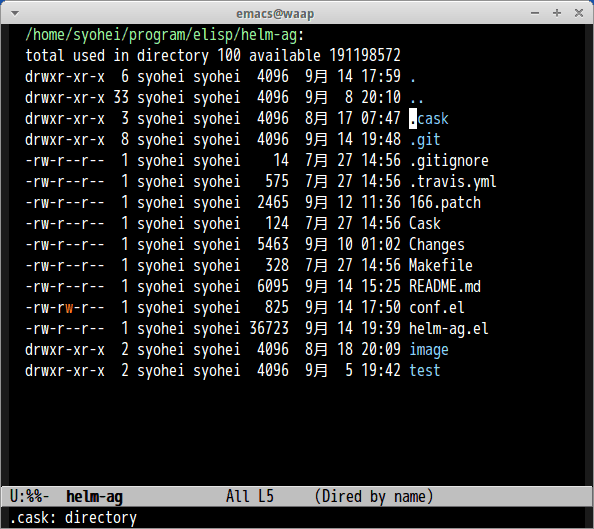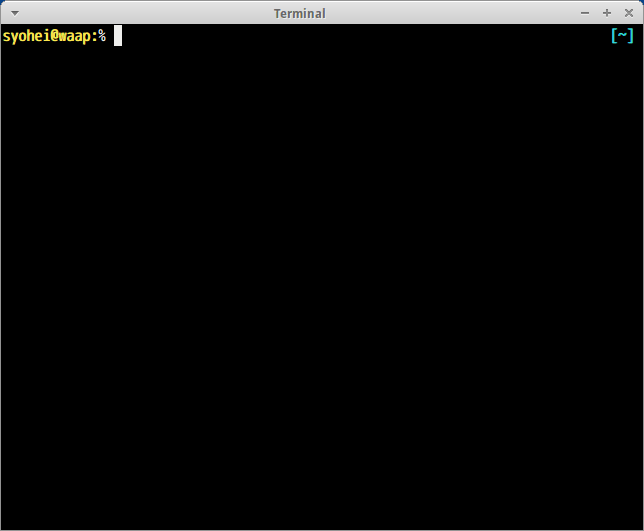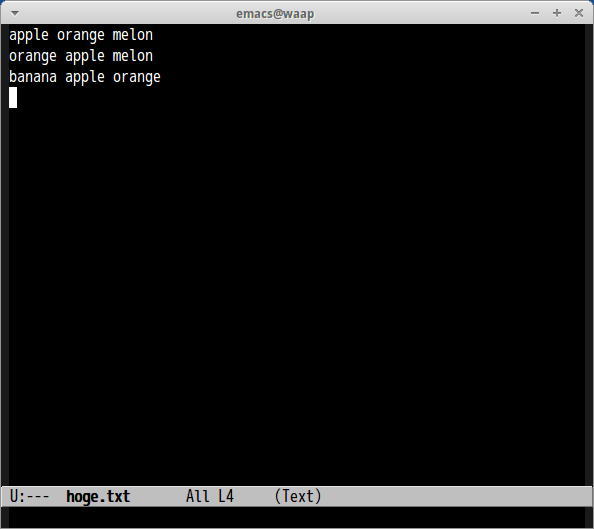helm-do-ag supports command line options
We can input command line options at helm-do-ag as following Gif animation.

If you want to use pattern which starts with -, please use -- separator.
集中線GIFメーカー in Golang
http://hitode909.hatenablog.com/entry/2015/09/13/205925
I wrote @hitode909's 集中線GIFメーカー(Awesome Web application) in Golang. This is command line application and you can use this as below.
Repository
https://github.com/syohex/speedline
Sample Output


Code
package main import ( "flag" "fmt" "math" "math/rand" "github.com/gographics/imagick/imagick" ) var ( output = flag.String("o", "output.gif", "output filename") color = flag.String("color", "black", "background color") ) func speedLine(mw *imagick.MagickWand, aw *imagick.MagickWand) error { cols, rows := mw.GetImageHeight(), mw.GetImageWidth() dw := imagick.NewDrawingWand() defer dw.Destroy() cw := imagick.NewPixelWand() cw.SetColor(*color) dw.SetFillColor(cw) center := []float64{float64(cols) / 2.0, float64(rows) / 2.0} const radiusCenter float64 = 0.75 const step float64 = 0.02 const bold float64 = 1.0 var theeta float64 for theeta < math.Pi*2 { stepNoise := rand.Float64() + 0.5 theeta += step * stepNoise radiusCenterNoise := rand.Float64()*0.3 + 1.0 boldNoise := rand.Float64() + 0.7 + 0.3 point0 := imagick.PointInfo{ X: math.Sin(theeta)*center[0]*radiusCenter*radiusCenterNoise + center[0], Y: math.Cos(theeta)*center[1]*radiusCenter*radiusCenterNoise + center[1], } point1 := imagick.PointInfo{ X: math.Sin(theeta)*center[0]*2 + center[0], Y: math.Cos(theeta)*center[1]*2 + center[1], } point2 := imagick.PointInfo{ X: math.Sin(theeta+step*bold*boldNoise)*center[0]*2 + center[0], Y: math.Cos(theeta+step*bold*boldNoise)*center[1]*2 + center[1], } dw.Polygon([]imagick.PointInfo{point0, point1, point2}) } if err := aw.DrawImage(dw); err != nil { return err } return nil } func main() { flag.Parse() imagick.Initialize() defer imagick.Terminate() mw := imagick.NewMagickWand() defer mw.Destroy() aw := imagick.NewMagickWand() defer aw.Destroy() if err := mw.ReadImage(flag.Arg(0)); err != nil { panic(err) } if int(mw.GetNumberImages()) == 1 { mw.SetIteratorIndex(0) first := mw.GetImage() mw.ResetIterator() for i := 0; i < 3; i++ { mw.AddImage(first.Clone()) } } for i := 0; i < int(mw.GetNumberImages()); i++ { mw.SetIteratorIndex(i) tw := mw.GetImage() aw.AddImage(tw) if err := speedLine(tw, aw); err != nil { fmt.Println(err) return } tw.Destroy() } mw.ResetIterator() aw.SetOption("loop", "0") if err := aw.WriteImages(*output, true); err != nil { panic(err) } }
Emacs daemon memo
Run named daemon
Emacs --daemon command line option can accept name argument(like --daemon=server1).
% emacs --daemon=vim -Q % emacs --daemon=atom -Q
Sending S-expression via emacsclient
And we can specify server by -s(--socket-name) option of emacsclient as below. (We can also specify socket file path instead of daemon name)
% emacsclient -s vim -e '(emacs-pid)' % emacsclient -s atom -e '(shell-command-to-string "vim --version")'
Shutdown emacs daemon
We can stop daemon by sending kill-emacs
% emacsclient -s vim -e '(kill-emacs)'
If you stop emacs daemon by kill command, you should also remove socket file at ${temporary-file-directory}/emacs${pid}/${servername} such as /tmp/emacs1000/vim.

Better space handling in helm-do-ag
I have implemented better space handling in helm-ag. If you want to input pattern which contains space, you can use escaped space like pattern1\ pattern2. Such pattern matches lines which have pattern1 pattern2. (While pattern1 pattern2 matches lines which have both pattern1 and pattern2.
Example

First I input apple orange. This pattern matches all lines because all line have both apple and orange. Second I input apple\ orange, first and third line are matched but second line is not matches because second line does not have apple orange
ac-emoji for Linux users
We can use emoji fonts other than MacOSX platform. (However MacOSX fonts is good looking :-()
Installing Symbola font
Download Symbola.ttf and put it into fonts directory such as ~/.fonts.
% cd ~/.fonts % curl -LO http://zhm.github.io/symbola/fonts/Symbola.ttf
NOTE
Debian/Ubuntu provides Symbola font as package, ttf-ancient-fonts or ttf-ancient-fonts-symbola. And some other distributions provide too. Please check your package system before installing Symbola font manually.
Configuration
Add following configuration in your init.el
(set-fontset-font t 'symbol (font-spec :family "Symbola") nil 'prepend)
Screenshot
We can use emoji on Linux now.

auto-complete source for Rust

Repository
https://github.com/syohex/emacs-ac-racer
How to use
- Install rust(https://www.rust-lang.org/install.html)
- Install racer(https://github.com/phildawes/racer)
(defun my/racer-mode-hook () (ac-racer-setup)) (add-hook 'racer-mode-hook 'my/racer-mode-hook) (custom-set-variables '(racer-cmd (expand-file-name "~/src/racer/target/release/racer")) '(racer-rust-src-path (expand-file-name "~/src/rustc/src")))
You must set racer-cmd and racer-rust-src-path. (racer-cmd is path of racer command. racer-rust-src-path is path of rustc source code)
Summary
ac-racer is alpha quality. Please report me via github issues or twitter if you have any suggestions or issues.
